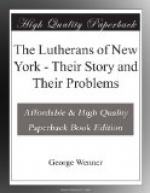Absorbed as we are in the local interests of our individual congregations and in the questions that divide us among ourselves, we seldom have an opportunity to give expression to outstanding principles of our church in such a way as to impress the public mind with a sense of their importance.
The question therefore continually recurs, why should these divisions be perpetuated among brethren who are agreed on the essentials of Lutheran teaching even though they may not have completely assimilated each other’s minute definitions of theological dogmas. Laymen, more interested in practical results, find it hard to understand why there should be so many different kinds of Lutherans. Even ministers, accustomed as they are to sharp distinctions, sometimes deplore these divisions and wonder when they can be healed. They long for the time when the adherents of the Augsburg Confession may unite in one great body, “beautiful as Tirzah, comely as Jerusalem, terrible as an army with banners.”
Alluring as such a prospect may seem, it is not of highest importance in a communion which from the beginning emphasized the right of private judgment and acquired for the world the right to think for itself in matters of conscience and religion. The Church of the Reformation derives its strength from unity rather than from union. Theoretically at least, it is a communion, a fellowship of believers. Its earliest designation was not “The Lutheran Church,” but “Churches of the Augsburg Confession.”
It is consonant therefore with our historic principles to respect the gifts and calling of the existing divisions in our churches without insisting upon an artificial union which could contribute little to the true unity of the church. There are “many members, yet but one body.... There are differences of administrations, but the same Lord.” In our mutual relations therefore it behooves us to recognize the rights of the individual.
This, however, need not prevent our working and praying for union. If it be possible, as much as lieth in us (unless this involves synergistic heresy), let us cultivate tolerance and live peaceably with all men, especially with all Lutherans.
We have in this city a great field in which there is work for us all. In friendly co-operation, rather than in hostile competition, we may escape some of the perils of our past history and perform with credit the tasks with which at present we seem to be struggling in vain.
The Metropolitan District includes the urban communities within ten miles of the boundary line of Greater New York. This territory of a hundred and fifty square miles now holds a population of over seven millions of people. Our churches in Greater New York minister to a baptized membership of 141,642 souls. If we include in our estimates of parochial responsibility, not merely enrolled members, but the entire Lutheran population of the District, Russians, Poles, Slovaks, Bohemians, Hungarians, Letts, Esthonians, Lithuanians, Dutch, Germans, Swedes, Norwegians, Finns and Danes, to say nothing of the multitudes of American birth from the Hudson and Mohawk valleys, from Pennsylvania, Virginia, Ohio and the West, the number of people claiming to be Lutherans amounts to more than five hundred thousand souls.




